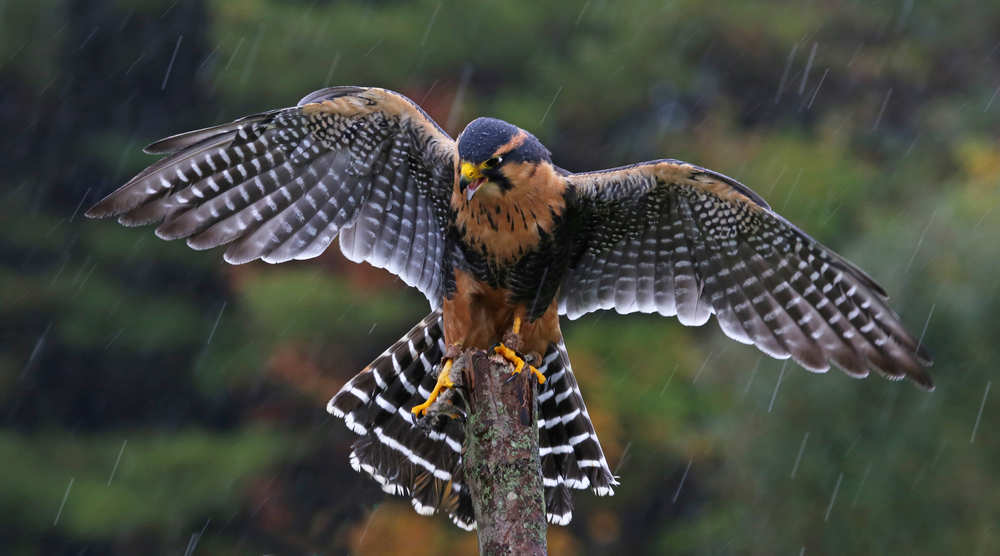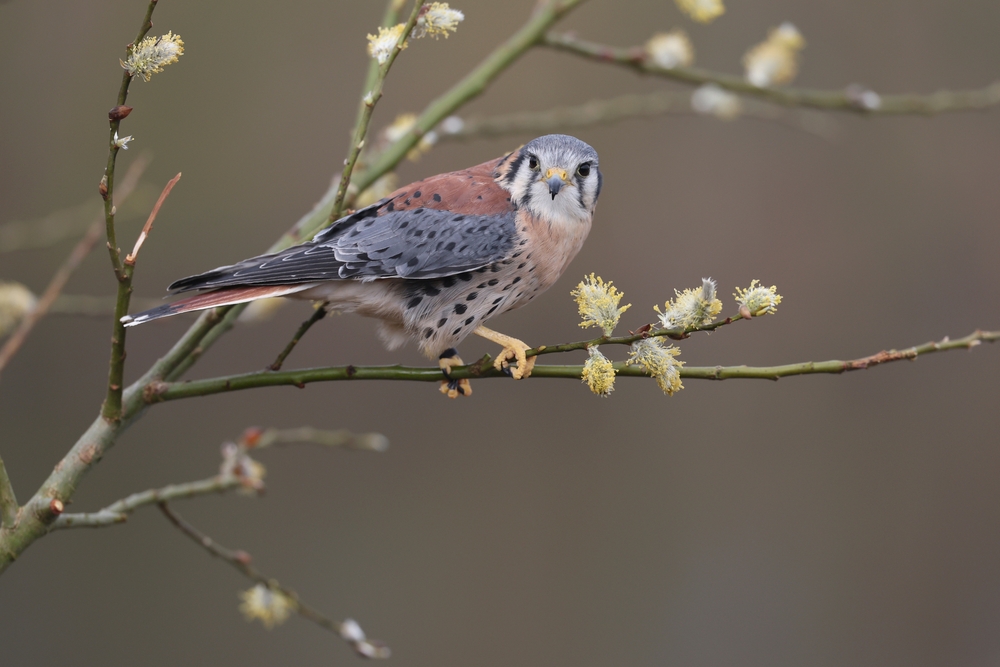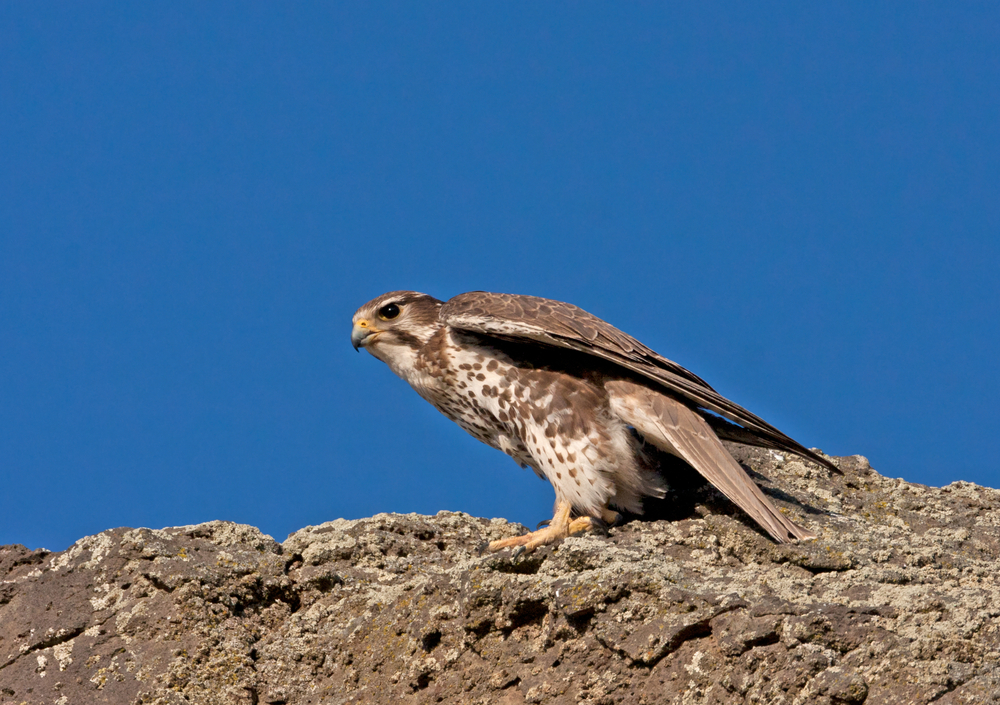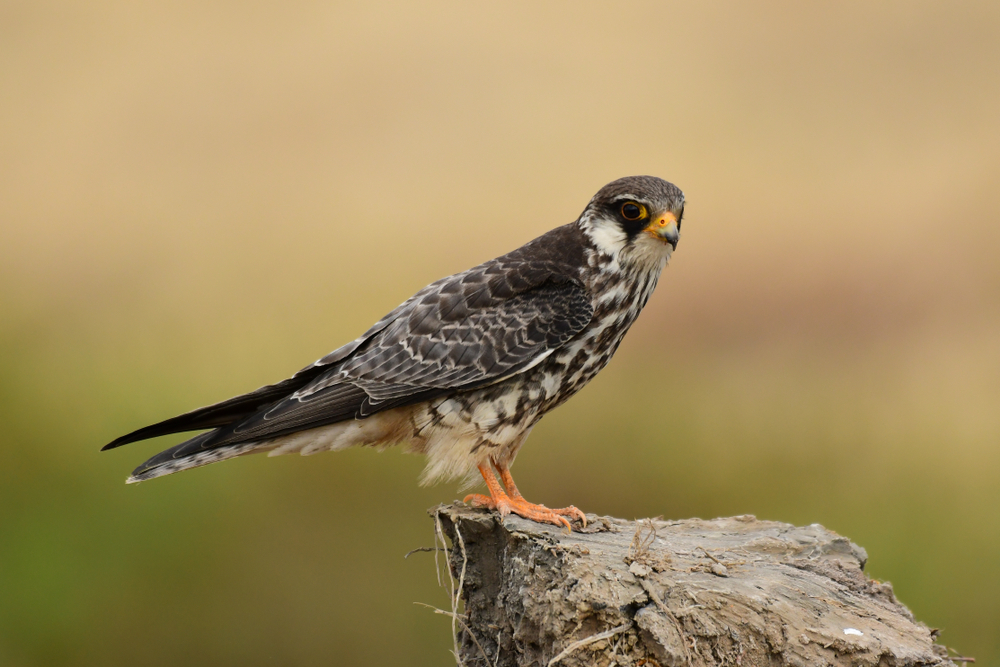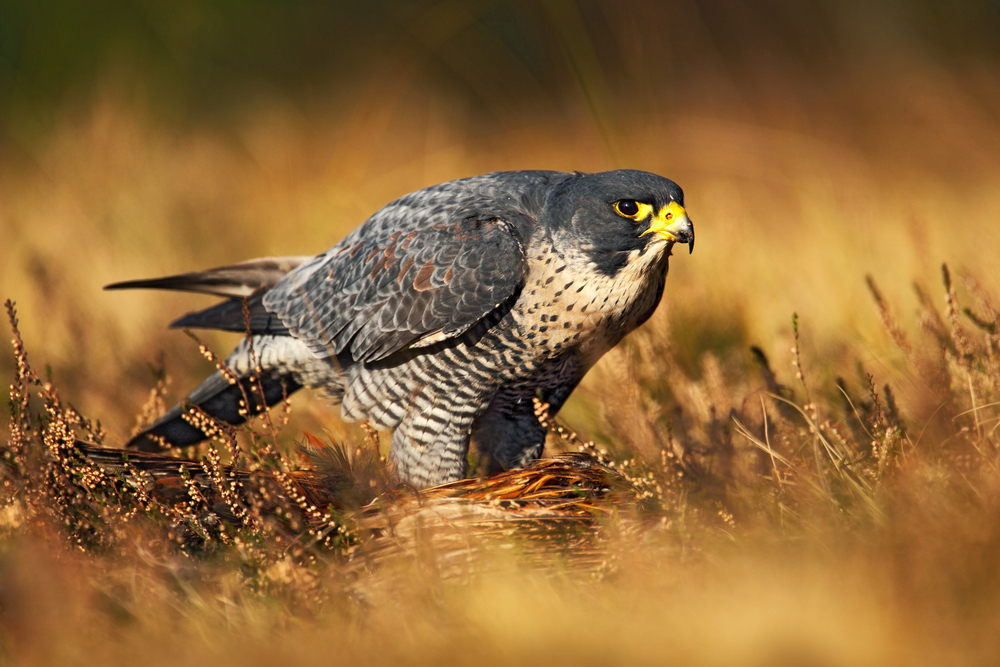The Aplomado Falcon (Falco femoralis) is most closely related to the Bat Falcon (Falco rufigularis) and the Orange-breasted Falcon (Falco deiroleucus), both of which share similar size, range, and striking plumage patterns.
About
The Aplomado Falcon (Falco femoralis) is a slender, long-winged raptor of the Falconidae family, found across Central and South America, with reintroduced populations in parts of the southwestern United States. Its name comes from the Spanish word aplomado, meaning “lead-colored,” a reference to its blue-gray upperparts. Sleek, fast, and strikingly patterned, it is one of the most elegant falcons of the Americas.
Measuring 34 to 45 centimeters (13 to 18 inches) in length with a wingspan of 89 to 102 centimeters (35 to 40 inches), the Aplomado Falcon resembles a small Peregrine but with a slimmer build. It has blue-gray upperparts, a white throat, bold black mustache stripe, and a buff underbody crossed by a distinctive black belly band. Its long tail, marked with white bands, enhances its agility in flight.
The diet of the Aplomado Falcon is diverse, consisting mainly of small to medium-sized birds, insects, and small mammals. It often hunts cooperatively in pairs, pursuing prey in fast, acrobatic chases through open grasslands, savannas, and desert scrub. This cooperative hunting behavior is unusual among falcons and increases their success rate.
Breeding typically takes place in open landscapes where falcons use old stick nests of other birds, often in trees, cliffs, or even cacti. Females usually lay two to four eggs, and both parents share incubation and chick-rearing duties.
Although listed as Least Concern overall, the Aplomado Falcon has declined in parts of its northern range due to habitat loss, overgrazing, and pesticide use. In the United States, reintroduction programs have helped restore small populations in Texas and New Mexico.
Graceful, swift, and beautifully marked, the Aplomado Falcon is a captivating symbol of open landscapes in the Americas.
Physical Characteristics
The Aplomado Falcon (Falco femoralis) is a medium-sized, long-winged falcon known for its elegant shape, bold markings, and agile flight.
Plumage:
-
Adults: Strikingly patterned with a slate-gray back and wings, contrasting with a white throat, bold black breast band, and rufous underparts.
-
Head: Features a white face with a bold black “mustache” stripe extending downward, giving it a fierce expression.
-
Juveniles: More brownish overall, with heavier streaking on the underparts and less distinct contrast in markings.
Head and Face:
The head is sleek with a sharply hooked beak suited for dispatching prey. The distinctive black facial stripe and pale eyebrow line enhance its fierce falcon appearance.
Body and Wings:
The body is slender, with long, pointed wings adapted for high-speed flight and aerial chases. Aplomado Falcons are particularly adept at pursuing prey in open landscapes, flying low and fast in horizontal chases.
Tail:
The tail is long, narrow, and prominently banded with black and white stripes, aiding maneuverability in pursuit flight.
Size:
-
Length: 14–18 in (35–45 cm)
-
Wingspan: 30–36 in (76–91 cm)
-
Height at Rest: About 15 in (38 cm) when perched
Weight:
-
Adult Male: 7–10 oz (200–280 g)
-
Adult Female: 9–16 oz (260–460 g)
The Aplomado Falcon’s long wings, banded tail, and bold black-and-white plumage distinguish it from other falcons, while its streamlined build equips it for sustained high-speed chases across grasslands and savannas.
Reproduction
The reproductive cycle of the Aplomado Falcon (Falco femoralis) is adapted to open-country living, with nesting occurring in savannas, deserts, and grasslands.
1. Mating and Courtship:
Aplomado Falcons are generally monogamous and form long-term pair bonds. Courtship includes aerial displays, food offerings by the male, and vocal calls to strengthen the pair bond.
2. Nesting Sites:
Unlike many raptors, they do not build their own nests. Instead, they reuse old stick nests of other birds such as crows, ravens, or hawks, typically placed in tall trees, cacti, or utility poles.
3. Egg Laying:
The female lays 2–4 eggs per clutch, usually between March and June depending on the region. Eggs are creamy or reddish with dark brown speckling.
4. Incubation:
The incubation period lasts 32–34 days. The female does most of the incubation while the male provides food.
5. Hatching and Care of Chicks:
Chicks hatch covered in white down and are completely dependent on their parents. The female broods the chicks continuously in the first two weeks, while the male hunts and delivers prey. Both parents later share feeding duties.
6. Fledging and Independence:
Young falcons fledge at about 5–6 weeks of age. Even after fledging, they remain near the nest site and continue to be fed by their parents for another 4–6 weeks while they master flight and hunting skills.
7. Breeding Frequency:
Most pairs raise a single brood per year, though re-nesting may occur if a clutch fails early.
The Aplomado Falcon’s breeding success depends strongly on prey availability and safe nesting sites, making conservation efforts—such as artificial nest platforms—important for supporting populations in restored habitats.
Lifespan
The lifespan of the Aplomado Falcon (Falco femoralis) varies depending on whether it lives in the wild or in captivity, with survival closely linked to prey availability and habitat quality.
Lifespan in the Wild:
In natural conditions, Aplomado Falcons typically live 8–10 years on average. However, many juveniles do not survive their first year due to predation, disease, or lack of food. The oldest known wild individual reached about 12 years.
Lifespan in Captivity:
In captivity, with veterinary care and a stable food supply, they may live up to 15–20 years. This extended lifespan reflects the absence of predators, accidents, and food scarcity.
Threats to the Aplomado Falcon:
-
Habitat Loss: Conversion of grasslands and savannas to agriculture and urban areas has reduced breeding and hunting grounds.
-
Pesticides & Chemicals: Contamination of prey species weakens reproduction and survival rates, echoing threats once seen in other raptors like the Peregrine Falcon.
-
Predation: Eggs and chicks are vulnerable to larger raptors, snakes, and mammals.
-
Weather Events: Extreme storms or droughts can reduce prey numbers and nesting success.
-
Human Disturbance: Logging, farming, and land development disrupt nesting areas.
Conservation programs—including habitat restoration, nest box placement, and reintroduction projects in the U.S.—have been critical for helping Aplomado Falcon populations rebound in certain regions.
Eating Habits
The Aplomado Falcon (Falco femoralis) is a swift, opportunistic hunter that feeds on a wide range of prey, using speed and agility to capture food in open-country habitats.
Diet:
-
Birds: Small to medium-sized birds make up the bulk of their diet, including doves, quail, shorebirds, and songbirds.
-
Insects: Large insects such as grasshoppers, dragonflies, and beetles are frequently taken, especially during warmer months.
-
Small Vertebrates: Occasionally feed on lizards, snakes, and rodents.
Hunting Strategy:
-
Aerial Pursuit: Known for spectacular, high-speed chases in open skies, often flying low and fast to surprise prey.
-
Cooperative Hunting: Unique among falcons, pairs sometimes hunt together—one flushing prey while the other captures it.
-
Ambush from Perch: They also hunt from perches, scanning the ground or air before launching into pursuit.
Feeding Behavior:
-
Prey is usually consumed on a perch, though smaller prey may be eaten mid-air.
-
During breeding season, the male delivers food to the female, often passing prey in flight.
-
They cache surplus food on branches or in nest sites.
Success and Adaptability:
The Aplomado Falcon’s ability to take both aerial and terrestrial prey gives it a flexible diet suited to grasslands, savannas, deserts, and coastal marshes. Their cooperative hunting behavior is rare among falcons and increases their efficiency, especially when targeting flocks of birds.
Uniqueness
The Aplomado Falcon (Falco femoralis) is a distinctive raptor with several traits that set it apart from other falcons.
Elegant Appearance:
Its striking plumage—slate-gray back, bold black breast band, and rich rufous underparts—gives it one of the most dramatic appearances among falcons.
Cooperative Hunting:
Unlike most falcons, Aplomado Falcons often hunt in pairs. This cooperative strategy allows them to flush and pursue prey more effectively, especially flocking birds.
Habitat Specialist:
They are strongly associated with open-country habitats such as grasslands, savannas, deserts, and coastal prairies, thriving where long sightlines favor high-speed aerial hunting.
Conservation Comeback:
Once largely extirpated from parts of the U.S. due to habitat loss and pesticides, the Aplomado Falcon has been the focus of reintroduction and recovery programs, particularly in Texas and New Mexico.
Cultural Significance:
The species’ name, “aplomado,” comes from Spanish, meaning “lead-colored,” referring to its slate-gray plumage. It has long been admired in Latin American falconry for its speed and beauty.
Adaptability:
Though specialized for open landscapes, it can adapt to semi-desert scrub, coastal marshes, and even man-made nest platforms, helping its populations recover in human-altered environments.
The Aplomado Falcon’s blend of striking looks, cooperative hunting, and conservation importance makes it one of the most charismatic and unique falcons of the Americas.
Be the First to Share Photos of This Species.
FAQ’s
1. What is the species closest to the Aplomado Falcon?
2. How does the Aplomado Falcon compare to other falcons?
The Aplomado Falcon is slimmer and longer-winged than many falcons, built for fast, sustained chases across open terrain. Unlike the Peregrine, which excels in steep dives, the Aplomado specializes in low, level pursuits and sometimes hunts cooperatively in pairs—unusual among falcons.
3. Which national parks provide the best opportunities to see an Aplomado Falcon?
Which national parks provide the best opportunities to see an Aplomado Falcon?
-
Big Bend National Park (Texas, USA): A stronghold for reintroduced populations in desert grasslands.
-
Laguna Atascosa National Wildlife Refuge (Texas, USA): Known for successful Aplomado reintroduction efforts.
-
Pantanal Matogrossense National Park (Brazil): Excellent for spotting wild populations in vast wetlands and open savannas.
-
El Palmar National Park (Argentina): Offers good viewing of Aplomados in native grassland habitats.



































































